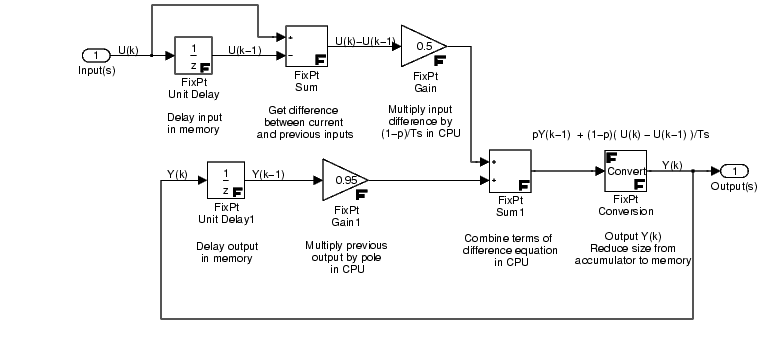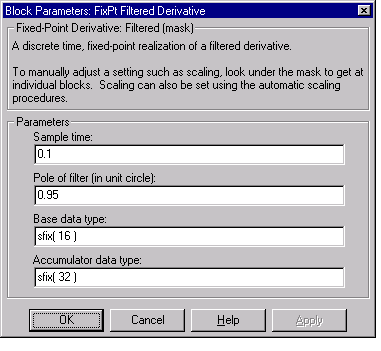| Fixed-Point Blockset |
  |
Derivative Realizations
This section presents realizations for a derivative and a filtered derivative. For each realization, the transfer function and difference equation, block parameters, and model design are discussed.
Filtered Derivative
The FixPt Filtered Derivative realization is a masked subsystem that performs discrete-time filtered differentiation. For this method, differentiation is approximated by the z-domain transfer function
where Ts is the sampling period and p is a pole on the unit circle. The realization is shown below.

As shown in the figure, the transfer function yields the difference equation
where k is the current time step, k - 1 is the previous time step, y(k) is the current output, y(k - 1) is the output from the previous time step, u(k) is the current input, and u(k - 1) is the input from the previous time step.
Parameters and Dialog Box
The dialog box and parameter descriptions for the filtered derivative realization are given below.

- Sample time
The time interval, Ts, between samples
- Pole of filter
The pole, p, is defined in the z plane so poles inside the unit circle are stable
- Base data type
The processor's base data type
- Accumulator data type
The processor's accumulator data type
Model Design Review
A brief review of the model design is given below. The design criteria reflect the rules presented in Design Rules.
- Using the Accumulator data type for the first FixPt Sum block would rarely be advantageous. Both inputs are given by the Base data type with identical scaling so using the same data type for the output makes sense. Also, the subsequent block is a gain, and its input should be the Base data type or smaller. The input values to this block should be close so the subtraction can be safely carried out using the Base data type.
- The gains involve multiplication which is a size-growing operation. In most cases, it is desirable for gains and inputs to use the word size given by the Base data type or smaller. The output can be left at the Accumulator data type for extra precision in subsequent operations. Alternatively, if the output were stored in RAM, or used by a size-growing operation, it could be reduced to the Base data type.
- The second FixPt Sum block converts inputs to the output data type before performing the actual addition. Given this order of operation, using Accumulator data type often gives better precision.
- The FixPt Conversion block forces the output to the Base data type before storage in RAM (before input to the unit delay). Converting the output in the feed forward part of the realization prevents subsequent operations from being burdened with a large data type.
 | Forward Integration | | Derivative |  |







